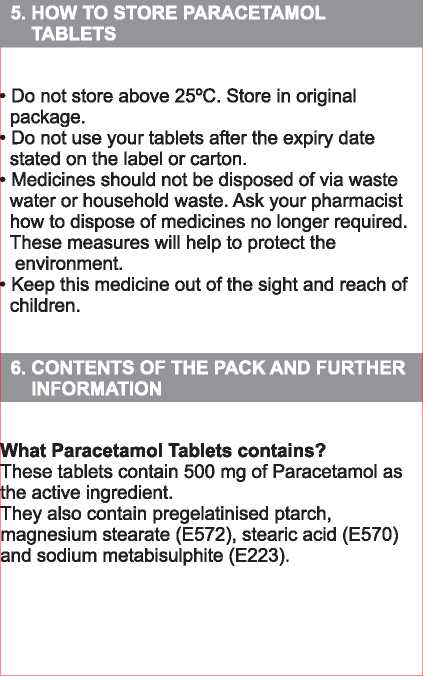Paracetamol Tablets 500mg
Package Leaflet: Information for the User PARACETAMOL TABLETS 500 MG Read all of this leaflet carefully before you start taking this medicine because it contains important information for you.
Always take this medicine exactly as described in this leaflet or as your doctor or pharmacist has told you.
• Keep this leaflet. You may need to read it again.
• Ask your pharmacist if you need more information or advice.
• If you get any side effects, talk to your doctor or pharmacist. This includes any possible side effects not listed in this leaflet. See section 4.
• You must talk to a doctor if you do not feel better or you feel worse after 3 days.
WHAT IS IN THIS LEAFLET
1. What Paracetamol Tablets is and what it is used for
2. What you need to know before you take Paracetamol Tablets
3. How to take Paracetamol Tablets
4. Possible side effects
5. How to store Paracetamol Tablets
6. Contents of the pack and further information
Tell your doctor if you are taking any of the following medicines:
• Anticoagulant to thin your blood such e.g. warfarin
• Medicines to control nausea and vomiting e.g. Metoclopramide or domperidone
• Medicines to control high lipid levels e.g. Colestyramine
Taking Paracetamol Tablets with alcohol
You should not drink alcohol whilst taking Paracetamol Tablets. Taking alcohol with paracetamol can increase your chances of getting side-effects
Pregnancy and breast-feeding:
Tell your doctor if you are pregnant or planning to become pregnant, or are breast-feeding.
Ask your doctor or pharmacist for advice before taking any other medicine.
Paracetamol Tablets contains Sodium Metabisulphite.
Paracetamol Tablets contain sodium metabisulphite which may rarely cause severe hypersensitivity reactions and bronchospasm (breathing difficulties^
3. HOW TO TAKE PARACETAMOL TABLETS
1. WHAT PARACETAMOL TABLETS IS AND WHAT IT IS USED FOR
Each Tablet contains 500 mg of the active ingredient Paracetamol. Paracetamol tablets belongs to a group of medicines called Analgesics and Antipyretics. Paracetamol Tablets are used for the treatment of mild to moderate pain including headache, migraine, neuralgia (severe pain in nerves), toothache, period pains and the symptomatic relief of sprain, strain and rheumatic pains.
They also reduce temperature and used for the symptomatic relief of feverishness, feverish colds and influenza.
2. WHAT YOU NEED TO KNOW BEFORE YOU TAKE PARACETAMOL TABLETS
Do not take Paracetamol Tablets:
if you are allergic to paracetamol or any of the other ingredients (listed in Section 6).
If you are taking any other medicines that contain Paracetamol
If children under 6 years of age
Take special care before taking Paracetamol Tablets:
if you have severe kidney or liver problems including non-cirrhotic alcoholic liver disease
Other medicines and Paracetamol Tablets
Please tell your doctor or pharmacist if you are taking or haverecently taken any other medicines. This includesmedicines obtained without a prescription,
Always take Paracetamol Tablets exactly as described in this leaflet or as your doctor or pharmacist has told you. You should check with your doctor or pharmacist if you are not sure.
For oral administration and short term use only. Swallow the tablets with water.
Dosage:
Adults, Eldery and children over 12 years
• Take 1-2 tablets up to four times a day as required.Do not take more than 8 tablets per day(24 hours)
Children between 6-12 years of age.
Take 1/4-1 tablet up to four times a day as required. Do not take more than 4 tablets per day (24 hours)
Wait at least 4 hours before taking another dose
Paracetamol Tablets should not be given to children under 6 years of age.
If you take more Paracetamol than you should
• Talk to your doctor even if you feel well because of the risk of delayed, serious liver damage
• Always take any tablets left over with you, also the box and leaflet as this will allow easier identification of the tablets
If you forget to take Paracetamol Tablets:
If you forget to take a dose, take it as soon as you remember. However, do not take a double dose to make up for a forgotten dose.
Remember to leave at least 4 hours between doses.
Like all medicines, Paracetamol can cause side effects, although not everybody gets them,
If you experience any of the following serious effects STOP taking this medicine immediately and contact your doctor or pharmacist:
Severe allergic reactions include:
• difficulty in breathing
• skin rash and itching
• swelling of the face and throat
• runny nose
Other possible side effects
• Occasionally the blood does not clot well, which may result in easy bruising or bleeding.
• Rarely, a severe reduction in the number of white blood cells, which makes infections more likely.
Very rare cases of serious skin reactions have been reported
Reporting of side effects
If you get any side effects, talk to your doctor or pharmacist. This includes any possible side effects not listed in this leaflet. You can also report side effects directly via the Yellow card Scheme at: www.mhra.gov.uk/yellowcard.
By reporting side effects, you can help provide more information on the safety of this medicine.
What Paracetamol Tablets look like and contents of the pack.
Paracetamol Tablets are white to off white, circular flat bevelled edge tablet with a breakline on one side and plain on the other, containing 500 mg of the active ingredient paracetamol.
Paracetamol Tablets are available in blister packs of 24 and 32 tablets.
Marketing Authorisation Holder Flamingo Pharma (UK) Ltd.
1st Floor, Kirkland House,
11-15 Peterborough Road,
Harrow, Middlesex,
HA1 2AX, UK.
Manufacturer:
Wave Pharma Ltd.
4th Floor Cavendish House,
369 Burnt Oak Broadway, Edgware,
HA8 5AW, UK.
If you would like this leaflet in different format information or want to report any side effects please contact marketing authorisation holder listed above.
This leaflet was last revised in:
October 2015
Pharmacode Reading Direction

J]
PL 43461/0006
PLL9001 NO MH/DRUGS/AD-096